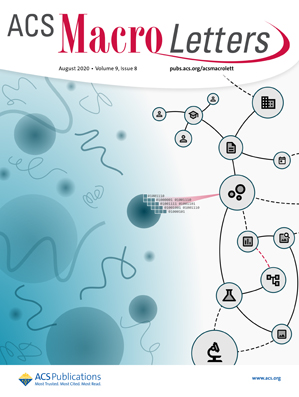在聚合物网络中加入可见光响应推拉偶氮苯以构建光动力水凝胶支架。
IF 5.2
Q1 POLYMER SCIENCE
引用次数: 0
摘要
力在调节细胞行为中起着至关重要的作用,而整合素是细胞用来感知力的主要例子。设计支架已被开发用于触发整合素介导的机械转导来控制细胞功能。然而,目前的支架缺乏三维基质中整合素机械刺激的时空控制。在这项研究中,合成了一种光反应性水凝胶支架,其中细胞粘附的推拉偶氮苯被共价加载到水凝胶上。偶氮苯的顺式-反式光异构化有望机械刺激整合素与与偶氮苯结合的细胞粘附肽(RGD肽;精氨酸-甘氨酸-天冬氨酸)的相互作用。合成的偶氮苯的光响应行为在蓝光开关后立即表现出光响应。通过点击反应,含偶氮苯的PEG有效交联,使细胞成功包封在含偶氮苯的水凝胶中。综上所述,光反应性水凝胶支架有望通过整合素介导的机械转导在四个维度上控制细胞行为。本文章由计算机程序翻译,如有差异,请以英文原文为准。
Incorporation of Visible Light-Responsive Push-Pull Azobenzene into Polymer Networks toward the Construction of Photodynamic Hydrogel Scaffolds.
Forces play vital roles in regulating cellular behavior, and integrins are prime examples that cells use to sense forces. Designer scaffolds have been developed to trigger integrin-mediated mechanotransduction to control cellular functions. However, current scaffolds lack spatiotemporal control of integrin mechanostimulation in a three-dimensional matrix. In this study, a photoresponsive hydrogel scaffold in which a cell-adhesive push-pull azobenzene was covalently loaded onto the hydrogel was synthesized. The cis-trans photoisomerization of azobenzene is expected to mechanostimulate the interaction of integrins with the cell-adhesive peptides (RGD peptide; arginine-glycine-aspartic acid) bound to azobenzene. The photoresponsive behavior of the synthesized azobenzene exhibited a photoresponse immediately after the on-off switching of blue light. The efficient cross-linking of azobenzene-bearing PEG through a click reaction allowed successful cell encapsulation in the azobenzene-bearing hydrogel. Taken together, the photoresponsive hydrogel scaffold is expected to find applications in controlling cellular behaviors in four dimensions via integrin-mediated mechanotransduction.
求助全文
通过发布文献求助,成功后即可免费获取论文全文。
去求助
来源期刊
CiteScore
10.40
自引率
3.40%
发文量
209
审稿时长
1 months
期刊介绍:
ACS Macro Letters publishes research in all areas of contemporary soft matter science in which macromolecules play a key role, including nanotechnology, self-assembly, supramolecular chemistry, biomaterials, energy generation and storage, and renewable/sustainable materials. Submissions to ACS Macro Letters should justify clearly the rapid disclosure of the key elements of the study. The scope of the journal includes high-impact research of broad interest in all areas of polymer science and engineering, including cross-disciplinary research that interfaces with polymer science.
With the launch of ACS Macro Letters, all Communications that were formerly published in Macromolecules and Biomacromolecules will be published as Letters in ACS Macro Letters.

 求助内容:
求助内容: 应助结果提醒方式:
应助结果提醒方式:


